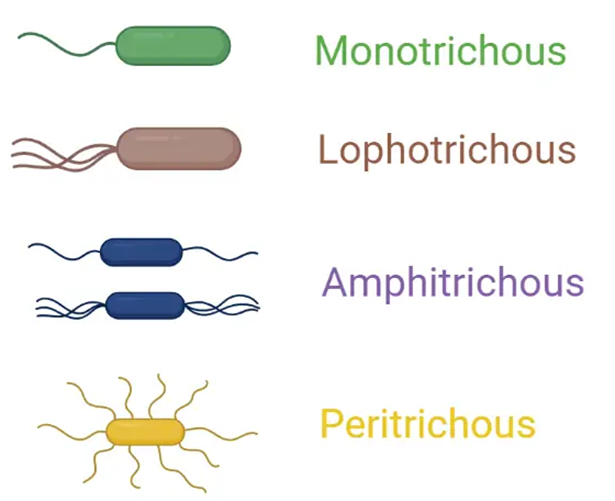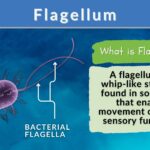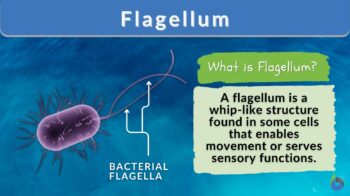
Flagellum
n., plural: flagella
[fləˈd͡ʒɛləm]
Definition: A long, whiplike cellular structure used for locomotion or feeding
Table of Contents
Flagellum Definition
Flagellum is a slender, hair-like structure composed of a complex arrangement of multiple proteins, lipids, and other molecular components. It is a remarkable biological structure that showcases the intricacy and efficiency of nature’s design. The word flagellum belongs to Latin origin that means “whip”. Found in various organisms, from bacteria to sperm cells, flagella are appendages responsible for propulsion and movement. Its function as a biological motor is crucial for the survival and locomotion of many microorganisms.
What makes the flagellum so remarkable is its ability to achieve rapid rotational speeds, reaching several hundred revolutions per second. The rotation generates a whipping motion, propelling the microorganism forward with impressive speed and agility. This incredible feat of mechanical precision allows bacteria to move toward favorable environments, avoid harmful substances, and search for nutrients.
The flagellum, with its diverse types and complex assembly, stands as a captivating structure responsible for the motility of countless bacterial species. Through the coordination of core flagellar proteins, the flagellum enables bacteria to swim, explore their environment, and establish infections.
The study of flagella provides valuable insights into molecular biology, evolution, and the mechanisms behind bacterial cell movement and pathogenicity. Studying flagella not only sheds light on the diversity of life on our planet but also inspires scientists and engineers to create artificial systems with similar capabilities. Researchers have drawn inspiration from the flagellum’s efficiency to develop micro-robotic systems capable of navigating through complex environments, potentially revolutionizing fields such as medicine, environmental monitoring, and nanotechnology.
Biology definition:
A flagellum (plural: flagella) is a long, slender, whiplike cellular structure used generally for locomotion. It is like a propeller that spins and pushes the cell forward, allowing it to go where it wants to go. In flagellated bacteria, the flagella are helical filaments made up of the protein, flagellin, and rotate like screws. In flagellated archaea, the flagella also consist of filaments protruding outside the cell. Nevertheless, the filaments rotate as a single assembly as opposed to bacterial filaments that rotate independently. In eukaryotes, such as in certain cells of animals, plants, and protists, they are made up of microtubules surrounded by the plasma membrane and enable the cells to move in a whip-like fashion. Apart from locomotion, flagella are used by some cells for other functions. Some of these functions include attachment to surfaces or host tissues, food capture, sensation, and signal transduction (e.g., rod photoreceptor cells of the eye, olfactory receptor neurons of the nose, and kinocilium in the cochlea of the ear).
Etymology: From Latin flagellum, meaning “whip”.
Compare: cilia
Structure of Flagella
Flagella are long, whip-like appendages, having a helical or spiral shape, allowing for efficient movement through fluids. The flagellum emerges from the cell surface and extends outward, providing motility to the organism. While there can be variations in flagellum structure among different organisms, there are some common flagellum components (Hu et. al. 2022):
Filament
The filament is composed of repeating protein subunits called flagellin proteins. Flagellin proteins are typically arranged in a helical or spiral structure, forming a long, flexible filament. The flagellin proteins provide the structural integrity and flexibility necessary for flagellar movement. The filament is primarily responsible for the propulsion and movement of the flagellum. It generates waves or undergoes rotational movements, propelling the organism through fluids.
Hook
The hook connects the filament to the basal body. It is composed of specialized proteins that are distinct from flagellin proteins. The hook is further composed of two regions: Connector Region and Bend Region. The connector region is the part of the hook that attaches to the filament. It forms a flexible joint between the filament and the hook, allowing for rotational movement. While the bend region of the hook is where the hook undergoes a sharp bend or curve. This bend region provides the flagellum with flexibility, allowing it to change direction and navigate through different environments
Basal Body
The basal body is the complex structure that anchors the flagellum to the cell membrane and provides the necessary machinery for flagellar movement. It provides structural support and stability to the flagellum. The motor proteins within the basal body generate the torque necessary for the rotational movement of the flagellum. It consists of several components which include:
- Rod. The rod is a rigid, tubular structure that extends from the hook into the cell. It is composed of specialized proteins and provides structural support to the flagellum. The rod acts as a backbone, maintaining the overall structure and stability of the flagellum. It helps transmit the rotational forces generated by the motor to the filament, resulting in flagellar movement.
- Rings
- L-ring: The L-ring, located in gram-negative bacteria, is an outer membrane protein ring that acts as a linker between the basal body and the cell envelope.
- P-ring: The P-ring, also known as the peptidoglycan ring, is found in the periplasmic space of gram-negative bacteria. It provides structural support by connecting the rod to the cell wall.
- MS-ring: The MS-ring, located in the cytoplasmic membrane, acts as a platform for the assembly of motor proteins. It provides a stable foundation for motor function.
- C-ring: The C-ring, also known as the rotor, is located at the base of the flagellum and is part of the motor complex. It allows rotational movement by interacting with the motor proteins.
- Motor. The motor is a complex protein system located within the basal body. It consists of a stator and a rotor.
- Stator: The stator is a group of proteins embedded in the cell membranes. It acts as a stationary anchor, interacting with the rotor to generate torque. The stator proteins are responsible for converting electrochemical energy into mechanical energy for flagellar movement.
- Rotor: The rotor is composed of the C-ring and associated proteins. It is responsible for converting the torque generated by the stator into rotational movement. The rotor allows the flagellum to rotate, propelling the cell through its environment.
Flagellar Assembly: biosynthesis and regulation
Flagellar biosynthesis
Flagellar biosynthesis refers to the process by which the flagellum is assembled and constructed. Flagella production is a highly complex and precisely regulated process involving numerous flagellar proteins. It involves the coordinated synthesis and assembly of various flagellar components, including the filament, hook, basal body, and associated proteins.
The specific steps involved in flagellar biosynthesis can vary among different organisms, but the general process includes the following key stages (Sun et. al., 2022):
- Transcription: Genes encoding flagellar components are transcribed into mRNA molecules.
- Translation: The mRNA molecules are translated into protein subunits, such as flagellin proteins and other structural proteins.
- Filament Assembly: Flagellin proteins are polymerized and arranged in a helical or spiral structure to form the filament.
- Hook Formation: The hook protein subunits are synthesized and assembled to form the curved region that connects the filament to the basal body.
- Basal Body Assembly: The various components of the basal body, including the rings, rod, and motor proteins, are synthesized and assembled. The basal body is anchored to the cell membrane.
- Export and Secretion: Several specialized protein export apparatus, such as the type III secretion system in bacteria, facilitate the export and secretion of flagellar proteins to their appropriate locations.
- Integration and Maturation: The different flagellar components, including the flagellar filament, hook, and basal bodies, are integrated and undergo maturation processes to become functional flagella.
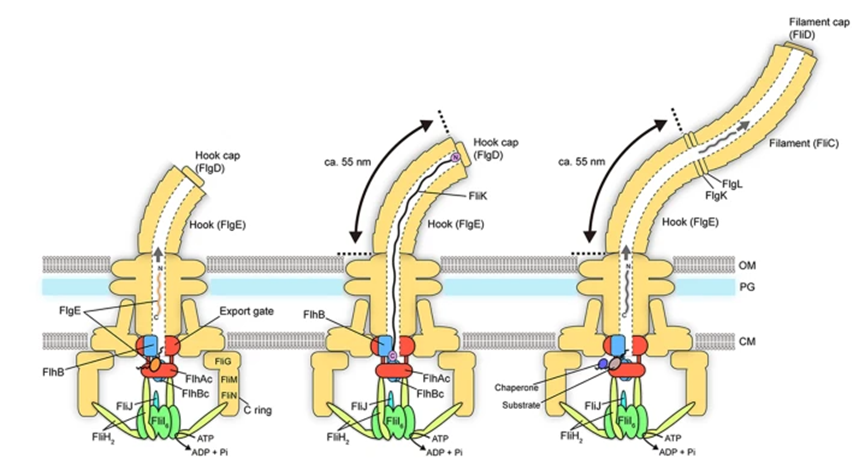
Filament Polymerization
Filament polymerization refers to the process of assembling the protein subunits into a long, helical structure to form the flagellar filament. This polymerization occurs at the growing tip of the flagellum, where the protein subunits are added sequentially, resulting in the elongation of the filament. This dynamic process allows the flagellum to extend and generate the necessary structure for bacterial motility.
Regulatory Mechanisms
The assembly and regulation of flagella are tightly controlled by various regulatory mechanisms that ensure proper flagellar formation and function. These mechanisms involve complex regulatory networks and signaling pathways that respond to environmental cues and cellular conditions.
Here are some examples of regulatory mechanisms involved in flagellar assembly (Kojima et. al., 2020).
- Transcriptional Regulation: Transcriptional regulators control the expression of genes involved in flagellar biosynthesis. These regulators can either activate or repress the transcription of flagellar genes based on specific signals or conditions.
- Post-transcriptional Regulation: RNA-binding proteins and small non-coding RNAs can modulate the stability, translation, and processing of flagellar mRNA molecules, influencing the synthesis and assembly of flagellar components.
- Chemotaxis Signaling: Chemotaxis is the ability of cells to move towards or away from specific chemical gradients. It involves specific chemotaxis genes and signaling pathways that regulate flagellar movement. These pathways sense environmental signals and modulate the rotation and direction of the flagellum accordingly.
- Protein Secretion and Export Systems: Specialized protein secretion and export systems, such as the type III secretion apparatus in bacteria, are involved in the transport and delivery of flagellar components to their correct locations within the cell.
- Protein-Protein Interactions: Various protein-protein interactions occur during flagellar assembly, where specific proteins interact with each other to facilitate proper assembly and anchoring of flagellar components.
These regulatory mechanisms ensure the controlled and efficient assembly of flagella, allowing organisms to respond and adapt to their surroundings. They help coordinate flagellar biosynthesis, regulate flagellar movement, and integrate flagella into cellular processes.
Function Of Flagellum
Here are the diverse functions of flagella in different organisms.
- Motility: The primary function of the flagellum is to act as a motility organelle, enabling the organism to swim (bacteria swim) or move in its surrounding medium. The flagellum achieves this through a mechanism called flagellar propulsion.
- Steering: Some organisms possess multiple flagella arranged in specific patterns. By altering the rotation and coordination of the flagella, the organism can change direction or exhibit more complex movements.
- Sensory Function: Flagella can act as sensory organelles, allowing organisms to detect and respond to changes in their environment. They can sense various external cues such as temperature, light, chemicals, and mechanical stimuli. These sensory signals are transmitted to the organism, enabling it to adjust its behavior, metabolism, or orientation in response to the detected stimuli.
- Attachment and Adhesion: In certain bacteria, flagella can aid in attachment to surfaces or host tissues. Some flagella possess adhesive properties that help bacteria adhere to surfaces, allowing them to form biofilms or establish infections. In these cases, the flagella assist in the colonization of specific niches or facilitate interactions with other cells or surfaces.
- Nutrient Acquisition: Flagella can contribute to the acquisition of nutrients in certain organisms. For example, in photosynthetic microorganisms such as algae, the flagella help position the cell in optimal light conditions for photosynthesis, maximizing the absorption of light energy. In some bacteria, flagella can also function as a means of gathering nutrients by promoting movement toward nutrient-rich areas or away from unfavorable conditions.
- Sensing and Response to Gravity: In certain organisms, flagella play a role in sensing and responding to gravity. For instance, in many algae and some aquatic microorganisms, the flagella help the organism orient itself relative to gravity. They enable the organism to either move towards or away from regions of higher gravity, optimizing their position in their aquatic environment.
- Communication and Signal Transmission: Flagella can also function as a communication device between cells. Some bacteria use flagellar movement to communicate with neighboring cells by coordinating their behavior or synchronizing certain processes. This communication can occur through the release of signaling molecules or by physical interactions facilitated by the movement of flagella.
- Fluid Flow and Mixing: In certain environments, the movement of flagella can create fluid flows that aid in the mixing or transport of substances. For example, in aquatic environments, the beating of flagella by microorganisms can generate currents that help disperse nutrients or distribute particles within the fluid.
- Cell Locomotion: Flagella serve as the primary means of movement for many organisms, enabling them to navigate through their environment. They allow cells to swim through liquids such as water or mucus, facilitating activities like finding food, escaping predators, or reaching optimal conditions for survival.
- Reproduction and Cell Division: In some organisms, flagella play a crucial role in reproduction. They are involved in the movement of sperm cells in animals and algae, aiding in the fertilization process. Additionally, during cell division, flagella may contribute to the separation of chromosomes and the proper distribution of genetic material.
- Biofilm Formation: Flagella can participate in the formation and maintenance of biofilms, which are communities of microorganisms attached to surfaces. By facilitating movement and allowing cells to reach suitable attachment sites, flagella contribute to the initial stages of biofilm formation. They also assist in bacterial surface colonization and the spread of microorganisms within the biofilm structure.
- Host-Pathogen Interactions: Flagella can play a vital role in pathogenicity and host interactions. They are crucial for the motility of many bacterial pathogens, allowing them to colonize host tissues, invade cells, and evade immune responses. The presence or absence of flagella can influence the virulence and infectivity of certain pathogens such as bacteria involved in urinary tract infections.
- Research and Biotechnology: The study of flagella and their mechanisms of movement has contributed to significant advancements in biology, microbiology, and biotechnology. Understanding how flagella function has implications for fields such as bacterial physiology, ecology, evolution, and the development of novel antimicrobial strategies (Akoshi & Bevins, 2022).
Examples of Flagellum: Flagella in Different Organisms
Here are the flagellar characteristics of different organisms with flagella:
Bacterial Flagella
Bacterial flagella are the most well-studied and common type of flagella. Flagellated bacteria are bacteria that possess flagella. They are composed of a filament, hook, and flagellar basal body, with rotary motion driving the propulsion of the cell. Bacterial flagella are involved in essential functions such as cell motility, chemotaxis, and biofilm formation. The structure and regulation of bacterial flagella can vary among different species, enabling adaptability to diverse environments. Enteric bacteria, such as Escherichia coli and Salmonella, possess flagella that play a crucial role in their survival and pathogenesis.
- Polar flagella: Polar flagella are tail-like appendages found in some bacteria, extending from one or both ends of the cell. They enable bacteria to move in a specific direction, helping them navigate toward or away from stimuli such as light, chemicals, or food sources. The single polar flagellum of some bacterial strains would occur as a solitary flagellum located at one end of the cell. This type of flagellar arrangement enables the bacterium to move in a specific direction, propelling itself forward or backward.
- Lateral flagella: It is a type of flagella found in certain bacteria that extend along the sides of the cell body. Unlike polar flagella, which are located at one or both ends of the cell, lateral flagella provide bacteria with the ability to move in a sideways or side-to-side motion. This unique adaptation allows bacteria to navigate through viscous environments or attach to surfaces in a different manner than bacteria with polar flagella.
- Type IV pili: Type IV pili are thin, hair-like appendages found in many bacteria. They are involved in various functions, including attachment to surfaces, twitching motility, and DNA transfer. Type IV pili are composed of pilin proteins that assemble into flexible filaments.
Bacterial flagella grow through a process called flagellar assembly. It involves the sequential addition of protein subunits to the growing tip of the flagellar filament. The flagellum starts with a basal body embedded in the cell membrane, which acts as a motor to drive flagellar rotation.
Gene duplication can contribute to the evolution and diversification of flagella by providing additional copies of genes involved in flagellar structure and function.
Example of bacterial flagellum:
Escherichia coli (E. coli) is a gram-negative bacterium commonly found in the intestines of warm-blooded organisms and serves as a prime example for studying bacterial flagella. E. coli possesses peritrichous flagella, allowing it to exhibit rapid and directed movement. The flagellar motor in E. coli is driven by the proton motive force, utilizing the flow of protons across the cell membrane. Flagella are not only essential for bacterial motility but also act as virulence factors, aiding in biofilm formation and host colonization.
Here is a vid showing the diagrammatic structure of E. coli’s flagellum:
Archaeal Flagella
Archaeal flagella, found in archaea, have structural and functional similarities to bacterial flagella but differ significantly in composition. Studies comparing their genetic or protein sequence similarity revealed how these two prokaryotic groups differ. One of the main differences has got to do with their flagellar composition. Archaeal flagellum is composed of multiple copies of a single protein (archaellin), in contrast to the complex protein sequences in bacterial flagella (whose filament structure is made up of flagellin and other proteins). Another difference is the mechanism of rotation. Archaeal flagella exhibit rotational motion but operate through distinct mechanisms, utilizing ATPases instead of the proton gradient or sodium ion gradient used by bacterial flagella.
Eukaryotic Flagella
Eukaryotic flagella, found in various eukaryotic organisms, including protists, algae, and animal cells, are structurally and functionally distinct from bacterial and archaeal flagella. The eukaryotic flagellum consists of microtubule-based structures called flagellar axonemes and exhibit beating motion rather than rotational motion. They are involved in diverse functions, including cell motility, sensory perception, fluid movement, and reproductive processes.
Example of eukaryotic flagellum:
The sperm cell has a flagellum that aids in its movement. In sperm cells, a single flagellum serves as the powerhouse, propelling the sperm through the female reproductive tract. The complex structure of the flagellum, composed of microtubules and molecular motors, provides the necessary force and flexibility for sperm cells to swim efficiently toward their destination.
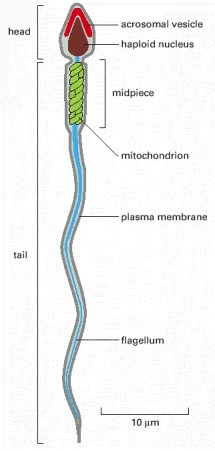
Types Of Flagellum
Here’s the list of the different types of flagellum:
- Monotrichous: Monotrichous flagella refer to a single flagellum located at one pole of the cell. It provides uni-directional movement and is commonly found in certain bacteria.
- Peritrichous: Peritrichous flagella are numerous flagella that are distributed all over the cell surface. These flagella allow the cell to move in various directions, providing a greater degree of motility. Many bacteria exhibit peritrichous flagella.
- Lophotrichous: Lophotrichous flagella are multiple flagella located at one or both poles of the cell. These flagella can be arranged in tufts or clusters and provide directed movement in specific directions. Some bacteria possess lophotrichous flagella.
- Amphitrichous: Amphitrichous flagella consist of a single flagellum at each pole of the cell. These flagella can rotate independently, allowing the organism to change its direction or exhibit a tumbling motion. Amphitrichous flagella are observed in certain bacteria.

Figure 4: Types of prokaryotic flagella. Image Credit: microbeonline.com - Prokaryotic motility structures include flagella, pili, and gliding mechanisms. Flagella are whip-like appendages used for locomotion. Pili are thin, hair-like structures involved in attachment and twitching movement. Gliding mechanisms enable bacteria to move smoothly across surfaces using specialized proteins or slime secretion.
What is the most common flagellar system?
The most common flagellar system is that of the bacteria. And among bacteria, the two flagellar systems commonly found are the monotrichous and peritrichous flagellar systems. The monotrichous system features a single flagellum at one end of the cell, allowing bacteria to move in a straight line. This system is often observed in bacteria like Escherichia coli. On the other hand, the peritrichous system involves multiple flagella distributed around the surface of the cell. These flagella work together to provide bacteria with the ability to move in various directions. Examples of bacteria with peritrichous flagella include Salmonella and Proteus species.
Mechanisms of Flagellum Motility
Flagellar motion can be achieved through different mechanisms depending on the type of flagella and the organism. The two main mechanisms of flagellar motion are (Nakamura & Minamino, 2019):
Rotational Motion
Rotational motion is characteristic of bacterial and archaeal flagella. In this mechanism, the flagellum rotates like a propeller, generating thrust and propelling the cell forward. The direction of rotation determines the movement of the cell. Clockwise rotation results in tumbling or random reorientation while counterclockwise rotation leads to smooth swimming in a straight line. The rotation of flagella is controlled by various regulatory mechanisms that respond to environmental signals and cellular cues. The primary factors involved in controlling flagellar rotation are:
- Chemotaxis: Bacteria exhibit bacterial chemotaxis, a process in which the direction of flagellar rotation is influenced by chemical gradients in the environment. Sensory receptors detect specific molecules, and signaling pathways regulate the direction of flagellar rotation, allowing bacterial cells to move toward favorable conditions or away from harmful substances.
- Phototaxis: Some microorganisms, particularly photosynthetic bacteria, and archaea, display phototaxis, where light serves as a directional cue for flagellar rotation. Photoreceptors detect light intensity and wavelength, modulating the rotation of flagella to optimize light absorption or avoid excessive light exposure.
- Signal Transduction: Various intracellular signaling pathways and protein-protein interactions control flagellar rotation. Signaling proteins (e.g., response regulators) phosphorylate flagellar motor proteins, thus, modulating their activity and influencing the direction and speed of flagellar rotation.
- Capping proteins play an important role in the regulation and assembly of flagella. In the context of the flagellum, capping proteins are involved in the control of flagellar filament growth. These proteins are responsible for capping the ends of the flagellar filament, preventing further elongation or disassembly. By regulating filament length, capping proteins help maintain the proper structure and function of the flagellum.
Beating Motion
Beating motion is observed in flagella and cilia of eukaryotic cells. Microtubule-based structures inside the flagella, known as axonemes, generate a bending motion that propels the cell or facilitates fluid movement. Dynein motor proteins generate sliding forces between adjacent microtubule doublets, causing the bending motion and resulting in the coordinated beating pattern.
Watch this vid about the flagella of prokaryotes and eukaryotes:
Did you know…?
The bacterial flagellum can rotate at speeds of 100s of revolutions per second, making it one of the fastest biological motors known to exist. This remarkable feat allows bacteria to swiftly navigate through complex environments and reach their desired destinations.
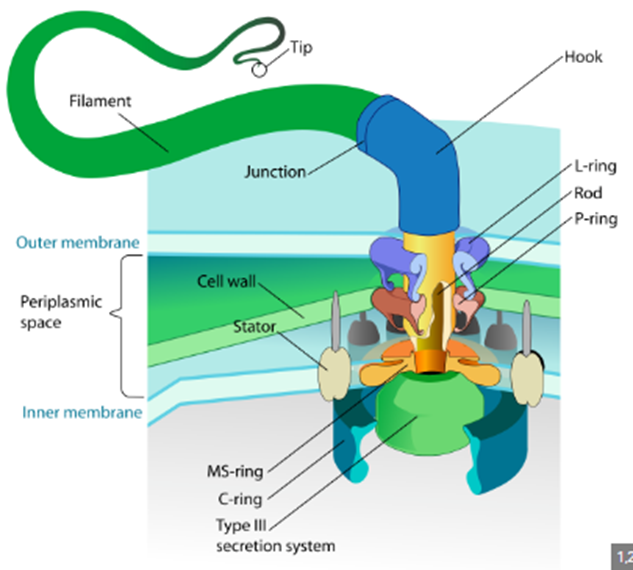
Take the Flagellum – Biology Quiz!
References
- Hu, H., Santiveri, M., Wadhwa, N., Berg, H. C., Erhardt, M., & Taylor, N. M. (2022). Structural basis of torque generation in the bi-directional bacterial flagellar motor. Trends in Biochemical Sciences, 47(2), 160-172.
- Sun, H., Wang, M., Liu, Y., Wu, P., Yao, T., Yang, W., … & Yang, B. (2022). Regulation of flagellar motility and biosynthesis in enterohemorrhagic Escherichia coli O157: H7. Gut Microbes, 14(1), 2110822.
- Akahoshi, D. T., & Bevins, C. L. (2022). Flagella at the host-microbe interface: key functions intersect with redundant responses. Frontiers in Immunology, 13.
- Kojima, S., Terashima, H., & Homma, M. (2020). Regulation of the single polar flagellar biogenesis. Biomolecules, 10(4), 533.
- Nakamura, S., & Minamino, T. (2019). Flagella-driven motility of bacteria. Biomolecules, 9(7), 279.
©BiologyOnline.com. Content provided and moderated by Biology Online Editors.
